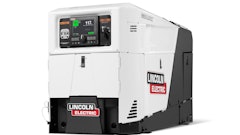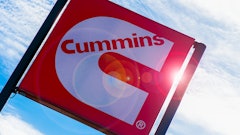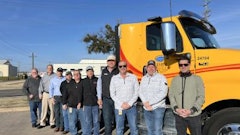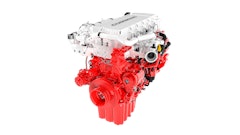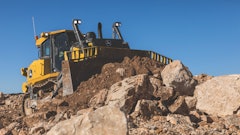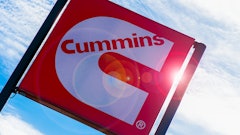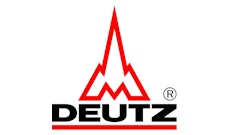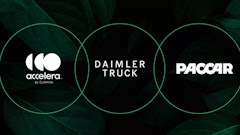Westport Innovations Inc., engineering the world's most advanced natural gas engines and systems, has reported financial results for the fourth quarter and year ended December 31, 2014 and provided an update on operations. All figures are in U.S. dollars unless otherwise stated.
Westport believes 2014 was a transformational year, cementing its position as the dominant player and technology leader in an expanding global market. For the first time, Westport's total segments revenue exceeded $1 billion; a significant milestone for both Westport and the natural gas engine and vehicle industry. This establishes natural gas as a global industry with a resilient ecosystem of engine, vehicles and system providers with the associated service/support and maintenance capabilities required for a new transportation fuel.
Despite this, observations of "slower than expected market uptake" have been raised about the state of the global natural gas vehicle market. The sudden and dramatic decline in global oil prices in the second half of 2014 caught most by surprise. While this volatility has created challenges in some markets and segments, in most parts of the world, the favorable price differential between natural gas and conventional fuels remains intact. The economic fundamentals of natural gas versus petroleum-based fuels are expected to remain strong even though lower and volatile oil prices are exerting pressure. Original Equipment Manufacturers (OEMs) have new natural gas products in development and the global network of fueling infrastructure continues to expand.
Fourth quarter and fiscal year 2014 highlights
Revenue & Net Results
- Westport is highlighting the combined segments for revenue for three main reasons: The global market for natural gas vehicles is growing despite some of the strongest headwinds in years; Westport believes that revenues from its own operations and joint ventures combined provide better clarity on the market's global picture; Westport expects much stronger returns from these segments this year towards its bottom line and thus, are critical pieces to its path to profitability.
- Total segments revenue, including Cummins Westport Inc. (CWI), Weichai Westport Inc. (WWI), and Westport Operations (combined Applied Technologies, On-Road Systems, and Off-Road Systems – see "New Segment Presentation Format in 2015") revenue, was $1.1 billion for the year ended December 31, 2014, an increase of 15% over the same period last year and a compound annual growth rate of 43% over the past three years.
- CWI joint venture segment revenue was $107.0 million on 3,382 units for the quarter ended December 31, 2014, the second strongest quarterly revenue in the joint venture history due primarily to strong growth in bus applications, with a record volume, up 136% from the same period last year.
- CWI reported record net income of $14.3 million for the quarter ended December 31, 2014, an increase of 276% from the prior year as the unfavorable warranty adjustments issue related to the Cummins Westport ISL G appears to be resolved. CWI reported a favorable warranty adjustment net of extended coverage claims of $4.7 million.
- CWI segment revenue was $337.2 million on 10,512 units for the year ended December 31, 2014, an increase of 9% in revenue compared to the prior year, and net income to Westport was $8.1 million for the year, a decrease of 14% compared to 2013.
- In North America, CWI unit volume increased by 28% year-over-year driven primarily by strong growth in trucking and bus applications, which are up 41% and 40%, respectively, over the same period in 2013.
- WWI joint venture segment revenue was a record $192.8 million on 16,176 units for the quarter ended December 31, 2014, an increase of 106% in revenue compared to the prior year. The full year numbers also set an all-time record of $618.5 million on 51,006 units, an increase of 33% in revenue compared to the prior year.
- In China, WWI solidified its dominant position in the natural gas heavy-duty engine market with over 70% market share at the end of 2014 with its WP10 and WP12 spark-ignited engines.
- WWI reported a record net income of $10.3 million and $17.2 million for the quarter and year ended December 31, 2014, respectively, compared with $1.9 million and $12.2 million, respectively, for the previous year, an increase of 442% and 42%, respectively. Net income to Westport from WWI for the quarter and year ended December 31, 2014 was a record $3.6 million and $6.0 million, respectively, an increase of 500% and 41%, respectively, compared to the prior year periods.
- Westport Operations revenue for the quarter ended December 31, 2014 was $27.4 million compared with $52.6 million for the same period last year. For the year ended December 31, 2014, revenue was $130.6 million. The prior year figures included $23.8 million of sales from the first generation of Westport™ high pressure direct injection (HPDI), which were concluded by December 31, 2013.
- For the quarter ended December 31, 2014, Westport reported an Adjusted EBITDA loss from operations of $11.6 million compared with $8.4 million in 2013. The increase in adjusted EBITDA loss is due primarily to severance costs and a one-time charge on an engineering program.
- Adjusted EBITDA loss from operations for the year ended December 31, 2014 was $17.7 million compared with $34.5 million for the year ended December 31, 2013. The improvement year-over-year was primarily due to the impact of consolidation and restructuring activities.
- For the quarter ended December 31, 2014, Westport reported a consolidated Adjusted EBITDA loss of $23.0 million compared with a loss of $23.2 million in the prior year period. This was due to overall improvement in cost structure, primarily offset by severance costs and a one-time charge on an engineering program.
- For the year ended December 31, 2014, Westport reported a consolidated Adjusted EBITDA loss of $83.9 million compared with a loss of $96.9 million in the prior year period. This improvement was primarily due to the consolidation and restructuring activities.
- During the quarter, Westport’s executives, seeing the long term value in Westport, accepted salary reductions in exchange for a grant of restricted share units, having a three year vesting period.
- Cash used in operations for the quarter ended December 31, 2014 was $23.4 million, a sequential decrease of $8.0 million from the quarter ended September 30, 2014 where cash used was $31.4 million. This is primarily due to improvements in working capital.
- Cash used in operations for the year ended December 31, 2014 was $106.8 million, a decrease of $10.0 million from the year ended December 31, 2013 where cash used was $116.8 million. This is primarily due to improvements in operations and reduced product investments.
- Westport consolidated net loss for the quarter ended December 31, 2014 decreased to $64.9 million from $89.5 million in 2013, an improvement of 27%, and consolidated net loss for the full year was $149.6 million, compared with $185 million in 2013, an improvement of 19%. The improvement in net loss for the quarter and year ended December 31, 2014 was primarily due to increases in consolidated gross margin and joint ventures’ income, combined with reduction in operational expenses.
"Despite volatile energy markets in 2014, market interest in alternative fuels continues to grow in many parts of the world," says David Demers, CEO of Westport. "Achieving over $1 billion in sales in 2014 highlights the dramatic growth in our market presence and prospects going forward, with 55% CAGR over the past five years. Our joint ventures posted record annual revenue with over 61,000 combined units sold during the year, representing approximately 2.7% of the global medium- and heavy-duty on-road engines sold in 2014. Development of our HPDI 2.0 heavy-duty vehicle products also made strong progress with development partners such as Delphi.
"Given current energy market and global economic volatility, we took significant steps in 2014 to advance our business model as we shift from many years of market creation and product demonstrations to full commercial operation and profitability. Q4 2014 saw us rapidly re-prioritize investment programs and reduce strategic investments resulting in a roughly 40% reduction going into 2015. We have prioritized investments and product development efforts to maximize our near term success by focusing on those markets that have the conditions needed for the adoption of natural gas and where we have tangible partner commitments. Some segments and applications like transit and refuse in North America, trucks and buses in China, and taxis and urban delivery vehicles in Europe and South America are already shifting from niche to mainstream.
"Our operating business units and joint ventures are all positioned for improved bottom line profitability in 2015, and if markets stabilize and recover, we should see strong leverage to the upside. That said, we remain committed to our strategic investment in HPDI 2.0 products and expect 2015 to be a breakthrough year for OEM commitments to HPDI 2.0 as the technology platform for their heavy-duty natural gas products.
"We made our commitment to company-wide adjusted EBITDA by the end of 2015 during a time of higher energy prices and stable demand growth. While confident in the variables that we can control, Q4 2014 has injected more risk and uncertainty from forces we do not control into our plans. We remain committed to the goal of consolidated positive cash flow from our global operations, and joint ventures by improving sales of existing products, maintaining a tight control of expenses and investments, completing our product development commitments for future products, reducing our core cash burn rate, and unlocking greater value from our joint ventures."
Four key components to Westport strategy in 2015
- Westport will continue to invest with committed OEM partners in commercial products for the next decade that contain strong technology content including HPDI 2.0 and enhanced spark ignited direct injection, but defer investments with uncertain market timing or commercialization risk.
- Westport will continue to rationalize and consolidate the Westport product portfolio for cost reduction and margin improvement, ensure customer value with leading price/performance, and achieve full system sales, creating and extracting value beyond individual component sales.
- Westport will look at non-core asset sales and are confident our portfolio of long-term investments can be supported from internal re-allocation and OEM partner co-investment.
- Westport will continue to drive cost efficiencies and reduce global overhead expenses.
Q4 2014 business highlights
- In December 2014, Westport announced it acquired Netherlands based Prins Autogassystemen Holding B.V. (Prins), a leading developer of high quality alternative fuel systems powered by liquefied petroleum gas (LPG or propane), compressed natural gas (CNG), and liquefied natural gas (LNG) for light-, medium- and heavy-duty applications. The combination of Prins' and Westport's team and technologies will further strengthen Westport's dominant technology portfolio.
- Westport delivered the last of four prototype LNG fuel tenders to Canadian National Railway (CN) for use in testing LNG locomotives. Westport will continue to support CN; however, Westport has paused further investment in LNG tender development until there is clarity on the timing of commercial LNG locomotive availability and associated customer demand.
- Westport invested $38.2 million toward HPDI 2.0 development during the year. The lead customer for HPDI 2.0 will be Volvo AB while Westport continues to develop HPDI products with other OEMs.
- Westport's natural gas vehicle sales through the Ford qualified vehicle modifier (QVM) program in 2014 were down 1% year-over-year, with challenging headwinds from much lower gasoline prices in the US. Westport has restructured the business through headcount reduction and facility consolidation to focus on lean operations and improved the operational results by 66% from adjusted EBITDA loss of over $10 million in 2013 to adjusted EBITDA loss of $3.7 million for the year ended December 31, 2014. Westport received certification from the US Environmental Protection Agency for its 2015 Ford Transit Van; and with this additional product and certification, further attention to cost containment measures, Westport expects the Ford QVM business to be at the breakeven point in 2015 even at current depressed sales volumes.
- Sales through the Volvo Car business unit stabilized and cost and margin improvements allowed the business to reach positive operating income for the first time.
- Westport appointed Mehran Rahbar, Executive Vice President, to be responsible for the Applied Technologies and On-Road Systems business unit. His career includes over 17 years with Siemens VDO Automotive in multiple divisions throughout Europe and North America with his last position being CEO & Executive Vice President of the Engine Actuators and Emission Management division. He also held executive positions with Continental Automotive Systems with his last position being Senior Vice President, Engine Systems, Global Operations. With his strong automotive background, Westport is strengthening its leadership team to transition from market creation and product demonstrations to full commercial operation.
- As part of streamlining activities and cost reduction efforts, Westport initiated a comprehensive study to improve the Applied Technologies' business performance. Several improvements related to productivity, supply chain, and warehouse efficiency have been implemented that resulted in immediate cost savings with remaining projects to be continued over the course of 2015. Westport also launched product cost reduction and product benchmarking activities to improve its engineering programs.
Cash and prioritization of investments
As of December 31, 2014, Westport recorded cash, cash equivalents, and short-term investment balance was $94.0 million.
Westport's primary motivation is to get the company to breakeven from a cash flow stance as soon as possible. Westport has a number of choices that can be made around investments and other research and development programs that will expedite this process. Additionally, Westport has a number of strategic alternatives to help reduce core expenses and cash burn and maintains the ability to divest certain non-core assets.
Westport reduced its combined operating expenses by over $23 million for the year ended December 31, 2014 compared to the year ended December 31, 2013. Several key actions were taken through 2014 to reduce operating expenses:
- Consolidation of facilities from 30 locations at the end of 2013 to 22 locations at the end of 2014.
- Restructured businesses such as Applied Technologies, Ford, ServoTech, and Volvo Car to focus on lean operation.
- Negotiated with current production suppliers.
- Pricing for CNG and LNG tanks, corporate logistics services, and facility maintenance.
- Consolidated volume for commonly used components by leveraging worldwide facilities consumption, resulting in savings on pressure sensors costs used in multiple products and applications.
- Reduction of global headcount.
- Reduction of general corporate expenses such as streamlining information technology activities and reduction to corporate bonuses.
Westport has rationalized and completed a number of development programs and reduced the overall number from 45 as of January 2014, down to 29 as of December 2014. Westport expects to further rationalize the development programs to a core group of 23 by the end of 2015 through continued prioritization of key technologies and programs, combined with completion of programs, which would reduce 2015 Corporate and Technology Investments' adjusted EBITDA results by approximately 40% from $66.2 million in 2014.
In the last 18 months, in an effort to reduce costs and align expenses with revenue, Westport has proactively rightsized the business since reaching its peak global headcount of 1,175 employees in Q2 2013 to 908 employees including full-time and contract or part-time employees as of December 31, 2014, a reduction of 23%.
Adjusted EBITDA
- For the quarter ended December 31, 2014, Westport reported an adjusted EBITDA loss from operations of $11.6 million compared with $8.4 million in 2013. The increase in adjusted EBITDA loss is due primarily to a one-time charge on an engineering program and severance costs. Adjusted EBITDA loss from operations for the year ended December 31, 2014 was $17.7 million compared with $34.5 million for the year ended December 31, 2013. The improvement year-over-year was primarily due to the impact of consolidation and restructuring activities.
- For the quarter ended December 31, 2014, Westport reported a consolidated adjusted EBITDA loss of $23.0 million compared with a loss of $23.2 million in the prior year. This was due to overall improvement in cost structure, primarily offset by severance costs and a one-time charge on an engineering program.
- For the year ended December 31, 2014, Westport reported a consolidated adjusted EBITDA loss of $83.9 million compared with a loss of $96.9 million in the prior year period. This improvement was primarily due to the consolidation and restructuring activities.
Westport is focused on improving its operational adjusted EBITDA contributions despite economic headwinds, and successfully completing the first commercial development of HPDI 2.0 vehicles with launch OEM customers. The path to breakeven for Westport has stronger headwinds now than when it was originally proposed in 2013, however, Westport is controlling what it can—rationalizing businesses, development programs, and technology investments—while looking for opportunities for incremental sales. Westport's current forecast for reaching consolidated breakeven (using adjusted EBITDA as a metric) is now mid-2016, with the following catalysts for earlier success:
- Stronger sales recovery in Westport operating units including Applied Technologies, Ford, and Volvo Car. Each 10% improvement in sales delivers approximately $3.5 million in adjusted EBITDA.
- Improved sales from Westport's joint ventures. Each 10% improvement in sales delivers approximately $3.0 million in annual adjusted EBITDA to Westport.
- Lower net investments and corporate expenses. This is expected to have a dollar for dollar impact.
Financial outlook for 2015
With continued uncertainty in global energy markets, and due to fluctuations in exchange rates, 2015 topline revenue forecasts are quite uncertain today. Nevertheless, Westport is forecasting modest growth in some markets and expects total segments revenue of approximately $1.1 billion for Westport Operations and joint ventures for the year ended December 31, 2015. Westport expects CWI to have modest revenue growth year-over-year due to the current energy prices; however the net income to Westport in fiscal year 2015 would improve as a result of identifying and resolving warranty issues associated with the Cummins Westport 8.9L ISL G. WWI is expected to see continued growth. Revenue from Westport Operations is expected to be between $110 million and $125 million, primarily due to currency fluctuations, volatility in US gasoline prices and continued economic uncertainty in Europe, offset by opportunities in new markets. Westport is able to provide revenue outlook for Westport Operations but will refrain from a specific revenue number on each of the joint ventures for competitive reasons.
The following conditions affect the revenue outlook for 2015:
- The impact of foreign currency translation from Euro to US dollar equivalent. Westport is currently expecting a range from US$1.15 to US$1.20.
- Sales of Westport's Ford QVM products are affected by customer expectations around gasoline fuel pricing, offset by continued commitment by larger fleets.
- Geopolitical uncertainty in key growth markets.
- Sales of new products including Westport iCE PACK™ dependent on the growth of LNG infrastructure, particularly advanced "cold" LNG stations.
Financial highlights
With continued uncertainty in global energy markets, and due to fluctuations in exchange rates, 2015 topline revenue forecasts are quite uncertain today. Nevertheless, Westport is forecasting modest growth in some markets and expects total segments revenue of approximately $1.1 billion for Westport Operations and joint ventures for the year ended December 31, 2015. Westport expects CWI to have modest revenue growth year-over-year due to the current energy prices; however the net income to Westport in fiscal year 2015 would improve as a result of identifying and resolving warranty issues associated with the Cummins Westport 8.9L ISL G. WWI is expected to see continued growth. Revenue from Westport Operations is expected to be between $110 million and $125 million, primarily due to currency fluctuations, volatility in US gasoline prices and continued economic uncertainty in Europe, offset by opportunities in new markets. Westport is able to provide revenue outlook for Westport Operations but will refrain from a specific revenue number on each of the joint ventures for competitive reasons.
The following conditions affect the revenue outlook for 2015:
- The impact of foreign currency translation from Euro to US dollar equivalent. Westport is currently expecting a range from US$1.15 to US$1.20.
- Sales of Westport's Ford QVM products are affected by customer expectations around gasoline fuel pricing, offset by continued commitment by larger fleets.
- Geopolitical uncertainty in key growth markets.
- Sales of new products including Westport iCE PACK dependent on the growth of LNG infrastructure, particularly advanced "cold" LNG stations.
Financial highlights
- The decrease in revenue for the quarter and year ended December 31, 2014 is primarily due to the discontinuation of the first generation Westport HPDI system in the prior year period, timing of service revenue, competition from gasoline-fueled vehicles due to the decrease in petroleum-based fuel pricing, unfavorable impact of foreign currency translation from Euro to US dollar equivalent, and weakness in key markets such as Europe and the Americas.
- The increase in gross margin percentage for the quarter and year ended December 31, 2014 is due to warranty adjustments and inventory net realizable write downs of $26.3 million taken in the year ended December 31, 2013 related to the discontinuation of the first generation Westport HPDI system.
- Research and development expenses were $19.3 million for the quarter ended December 31, 2014, a decrease of $4.0 million from $23.3 million in the same period last year. Research and development expenses were $76.6 million for the year ended December 31, 2014, a decrease of $14.5 million from $91.1 million in the same period last year. These expenses were driven by a reduction in program expenses and prioritizing of investment programs.
- Selling, general and administrative expenses were $15.7 million for the quarter ended December 31, 2014, a decrease of $9.5 million from $25.2 million in the same period last year. Selling, general and administrative expenses were $65.8 million for the year ended December 31, 2014, a decrease of $9.7 million from $75.2 million in the same period last year. The decrease is primarily due to staff reductions as a result of consolidation of facilities and discontinuation of activities related to the first generation Westport HPDI system.
Westport operations highlights
Applied Technologies, On-Road Systems, and Off-Road Systems
- Applied Technologies revenue for the year ended December 31, 2014 decreased by 8% to $86.2 million compared with $93.2 million in the prior year period primarily due to unfavourable impact of foreign currency translation from Euro to US dollar equivalent and weakness in key markets such as Europe, particularly Italy, Russia and other Eastern European countries, and the Americas. However, this was offset by increases in markets such as Germany, Poland and India.
- Applied Technologies gross margin and gross margin percentage for the year ended December 31, 2014 decreased to $21.7 million and 25.2%, respectively, compared with $26.5 million and 28.4%, respectively, in the prior year period primarily due to a change in product mix and weaknesses in key markets including a large part of Europe and the Americas.
- Applied Technologies operating expenses for the year ended December 31, 2014 increased by $7.2 million compared to the prior year period primarily related to new product development programs, increase in scope of business to include China operations, allowance for doubtful accounts, customer support campaign expense and severance recorded during the year.
- On-Road Systems revenue for the year ended December 31, 2014 decreased by 33% to $37.0 million compared with $55.1 million in the same period last year due primarily due to the discontinuation of the first generation Westport HPDI system at the end of 2013 representing $23.8 million in revenue.
- On-Road Systems gross margin and gross margin percentage for the year ended December 31, 2014 increased to $7.0 million and 18.9%, respectively, from negative $23.9 million and negative 43.4%, respectively primarily due to a change in product mix. The increase in gross margin is primarily due to the inclusion of warranty adjustments and inventory net realizable write downs of $26.3 million in the year ended December 31, 2013 related to the discontinuation of the first generation Westport HPDI system.
- On-Road Systems operating expenses for the year ended December 31, 2014 decreased by $14.6 million compared to the prior year period due primarily to lower research and development expenses on the Westport WiNG system as product development completed in 2013, decreased headcount from consolidation of facilities, discontinuation of activity related to the first generation Westport HPDI system, and general cost reductions.
- Off-Road Systems revenue for the year ended December 31, 2014 increased by 15% to $3.8 million compared with $3.3 million in the prior year period. New products included the four LNG tenders delivered to CN.
Cummins Westport
- CWI generated record year sales and volume for the year ended December 31, 2014, up 9% and 2%, respectively, compared to the prior year. Excluding international sales, which are always volatile, CWI unit volume in 2014 was up 28%.
- The increase in CWI gross margin percentage during the quarter ended December 31, 2014 is primarily due to a favorable warranty adjustment as a result of identifying and resolving warranty issues associated with the CWI 8.9L ISL G. Favourable warranty adjustments and net extended coverage claims totaling $4.7 million were recorded in the quarter ended December 31, 2014, compared with non-favorable warranty adjustments and net extended coverage claims totaling $21.3 million in the prior year period.
- The increase in operating expenses from $40.7 million to $44.8 million is primarily driven by a product development for the ISB6.7 G natural gas engine, which is expected to launch in 2016.
- CWI's net income attributable to Westport for the year ended December 31, 2014 was $8.1 million compared with $9.4 million in the prior year period. Warranty adjustments and net extended coverage claims totaling $21.7 million were recorded for the year ended December 31, 2014. Excluding the warranty impact, CWI's net income attributable to Westport would have been $16.0 million.
Weichai Westport
- WWI generated record quarter and record year on sales, volume, and net income for the period ended December 31, 2014. WWI continues its strong growth primarily due to the tightening of China's diesel emission standard from National III to National IV which has created a significant increase in the price of diesel engines, resulting in stronger demand for natural gas engines.
- For the quarter and year ended December 31, 2014, gross margin increased by 197% and 41%, respectively due primarily to product mix to higher margin engine sales and improvement in production efficiencies.
- Operational expenses increased $9.1 million for the three months ended December 31, 2014 compared to the same period in 2013 due primarily to higher product development costs and increased support costs associated with the rapid growth over the previous year.
New segment presentation format for 2015
As Westport narrows the focus within certain business units and defers certain products and related programs, it makes sense to combine operational business units into one "Operations" reporting unit and properly reflect the nature of Westport's own product and systems revenue. As of January 1, 2015, Westport will report the total for the Applied Technologies, On-Road Systems, and Off-Road Systems segments as "Westport Operations." Westport plans to continue to report Corporate and Technology Investments and the two major joint ventures as separate segments.













